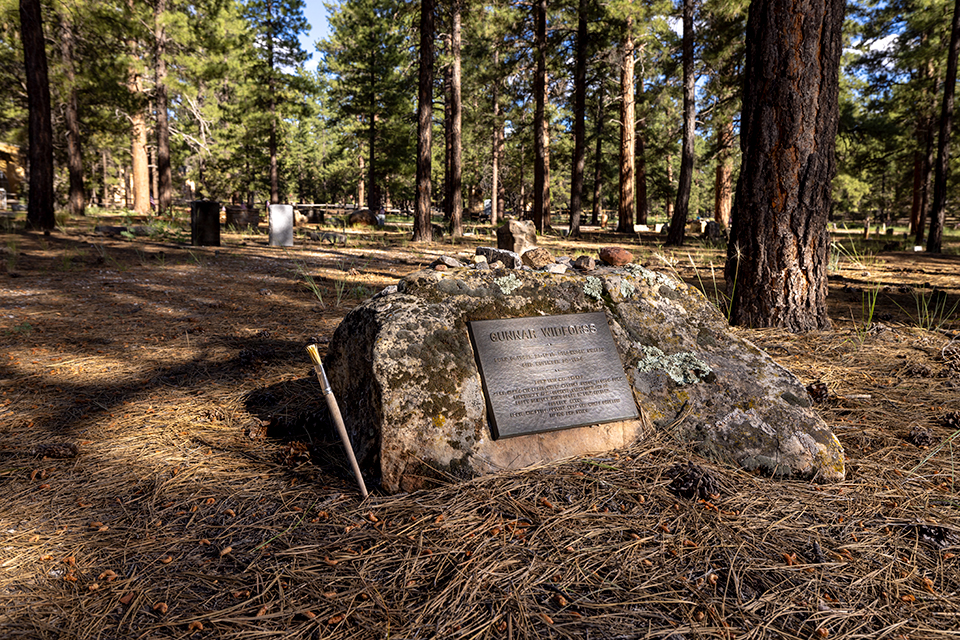The Pioneer Cemetery at the Grand Canyon’s South Rim is a who’s who of early 20th century Canyon history. Of the roughly 400 people buried here, only about 10 percent are famous. But in some ways, the unfamiliar names are just as interesting.
I’ve come so early that mine is the only vehicle in the Shrine of the Ages parking lot. The air is fresh and scented of ponderosa pine. Past the arched gate (above) are granite slabs with plaques for information, although a petrified wood marker also catches my eye. Some rough stones have no inscriptions. Even sadder are faded-to-unreadable wooden markers. These people were intended to be remembered and now cannot be.
First resident John Hance, famous for telling irreverent tales to early tourists, was buried here in 1919, before this was officially a cemetery. It would be nine years before the National Park Service and the American Legion dedicated the new burial ground.
Strolling through, I recognize Gunnar Widforss (opposite page) from his signature on paintings displayed at El Tovar. Other prominent residents include John Verkamp, honored by Verkamp’s Visitor Center for the curio business he founded on the South Rim, and Ken Patrick, the first Park Service ranger to be murdered in the line of duty. Ralph Cameron is here, too, reminding me of the time I got out of my car at Cameron Trading Post as my dad exited his convertible with my 5-year-old son, who was asking, “And is Ralph Cameron still alive, Poppa?” I gloried in hearing Canyon stories passed to another generation — even stories of Cameron, who could be painted as a statesman or a scoundrel but was an undeniable force in Canyon lore.
Here also are Emery and Ellsworth Kolb, whose legacies live on at Kolb Studio. The industrious early photographers would make pictures of tourists in the Canyon, run ahead to Indian Garden (now Havasupai Gardens) for water to develop the film, and sell the images when the mule-riding visitors came back up the Bright Angel Trail. A coin toss in later, less harmonious years allowed Emery to stay while Ellsworth moved, so it’s nice to see them both back here, along with Emery’s wife and daughter.
Equally noteworthy, for a much different reason, is the monument for some of the 128 people killed when two planes, one United and one TWA, collided over the Canyon in 1956 — an incident that spurred the creation of the modern air traffic control system. Remains from the United flight are here, while those of the TWA victims are in a cemetery in Flagstaff.
But less-famous names have stories, too. We get clues: Lizzie Clawson has only March 15, 1922, inscribed on a tall stone, which a casual observer might assume makes her a newborn of grieving parents. In truth, though, she was born in 1863 and was married to a Santa Fe Railway employee also buried here. Frederick “Ed” Tisi, who died at 22 in 2000, clearly sees regular visitors at his well-kept grave, which sits next to a raw, flower-covered mound.
Another lavishly bedecked site is that of Paco Nathan Hunter, who rests next to Jessica Ruth Cochran, described as his soul mate. Their inscriptions show how deeply the 21-year-olds’ loss was felt when they died on the same day in 2004. A Google search provides sad clarity: The young couple, both of whom grew up at the Canyon, were killed in a car crash east of Prescott. Roy Lemons is also unknown to me, but when I get home, I read that he helped install telephones at the Canyon and married a Harvey Girl from El Tovar and Bright Angel Lodge.

I’ve come here before with my father, my earliest and best teacher in all things Grand Canyon. This is my first time back without him, which perhaps is why seeing the stone inscribed “Daddy” catches my eye. It belongs to James C. Stewart, who died at only 45. More elaborate are the two markers for Marvin William Gustafson, who was 73 when he died in 2003. He inspired several lines of inscription, including: “Here he pursued his quest to live fully, to be forever learning, to grow in spirit.”
Pioneers who are here remind me of some who are not but, in my opinion, should have a monument. One is boatman Bert Loper, who died in the Colorado River’s 24.5 Mile Rapid just shy of his 80th birthday. On my own river trips, our guide, Jim Norton, described Loper’s vigor into old age. Another who deserves a tribute is Harvey Butchart, who didn’t hike in the Canyon until he was 38 but logged so many exploratory miles thereafter that one Northern Arizona resident said wistfully, “It’s a shame we haven’t yet figured out how to download the contents of the human brain, because when Harvey Butchart died, the world lost half of its knowledge of the Grand Canyon.”
While the early deaths stand out, many Canyon pioneers were remarkably long-lived. Emery Kolb died at 95, and his brother, Ellsworth, lived to 84. Cameron was 89, while William Wallace Bass was 84. Margaret Ann Nelson Thune was born in 1919 and died at almost 99, while her brother and sister-in-law, buried behind her, lived to be 100 and 91, respectively. (The cemetery officially closed to new residents in 2017, but some burials continue for those with plots reserved before then.)
It makes me wonder if those early Canyon contributors shared the trait of nimbly avoiding ruts. None ended up here by living a prescribed life that echoed those of their parents. Indeed, perhaps exercise, fresh air and enthusiasm are common traits that proved an elixir for not just living deeply, but also living long.
SOUTH RIM Grand Canyon Pioneer Cemetery, 928-638-7888, nps.gov/grca
EDITOR'S NOTE: A previous version of this story misstated the particulars of cemetery resident Lizzie Clawson. The story has been updated. We regret the error.

